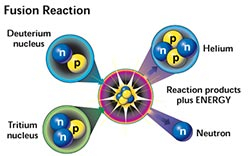Fusion science, which seeks to recreate the energy of the stars for use on Earth, has long been the holy grail of energy researchers. The discipline has its skeptics, but officials at Livermore Livermore National Laboratory (LLNL) are confident that commercially viable fusion power plants will be possible within the next few decades.
 Ever since it was founded in the early 1950s, LLNL has been developing methods to unlock the mystery of fusion power. There are two principle techniques: magnetic fusion and inertial confinement fusion (ICF). When the laser was invented in 1960, Livermore scientists glommed onto the idea of using convergent beams of light to ignite a fusion micro-explosion. Researchers at Lawrence Livermore’s National Ignition Facility (NIF) continue to pursue the goal of achieving controlled thermonuclear burn in the laboratory using laser light.
Ever since it was founded in the early 1950s, LLNL has been developing methods to unlock the mystery of fusion power. There are two principle techniques: magnetic fusion and inertial confinement fusion (ICF). When the laser was invented in 1960, Livermore scientists glommed onto the idea of using convergent beams of light to ignite a fusion micro-explosion. Researchers at Lawrence Livermore’s National Ignition Facility (NIF) continue to pursue the goal of achieving controlled thermonuclear burn in the laboratory using laser light.
On Aug. 13, 2013, all 192 of the ultra-powerful laser beams at NIF converged on a tiny deuterium-tritium filled capsule. In a matter of nanoseconds, the capsule imploded and released a neutron yield of nearly 3×10^15, or approximately 8,000 joules of neutron energy. It was a record-setting yield, three times higher than previous efforts.
According to an official lab announcement, “this newest accomplishment provides an important benchmark for the program’s computer simulation tools, and represents a step along the ‘path forward’ for ignition delivered by the NNSA to Congress in December 2012.”
The lab’s computers have just begun to analyze the results, but initial calculations are promising. LLNL reported that “fusion reactions in the hot plasma started to self-heat the burning core and enhanced the yield by nearly 50 percent, pushing close to the margins of alpha burn, where the fusion reactions dominate the process.”
Ed Moses, principle associate director for NIF and Photon Science refers to the experiment as an “important advance in establishing a self-sustaining burning target, the next critical step on the path to fusion ignition on NIF.”
NIF experiments are orchestrated by a sophisticated computer system located in the facility’s control room. The machine has 950 front-end processors linked to 60,000 control points, including mirrors, lenses, motors, sensors, cameras, amplifiers, capacitors and diagnostic instruments.
The US continues to invest in fusion science because of its long-term potential as a safe, virtually-unlimited environmentally-benign energy source. Experiments have resulted in short-lived self-sustaining burns, but the energy input was greater than the energy output. To be viable, fusion energy needs to produce an energy surplus that can generate a continuous stream of electricity.
Besides its significance to fusion science, the recent experiment also supports NIF’s mission to ensure the nation’s security without nuclear weapons testing. These controlled micro-explosions add to the evidence that the stockpile can be kept secure and safe without a return to live nuclear testing.
Related Articles
NERSC Managers Shed Light on ‘Edison’
Finnish Researchers Welcome New Cray Super
Simulations Uncover Obstacle to Harnessing Laser-Driven Fusion



























































